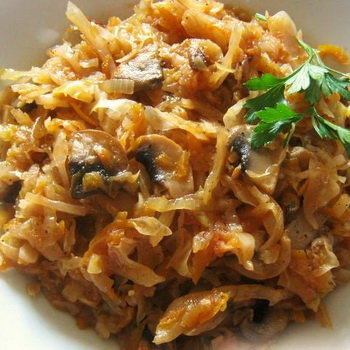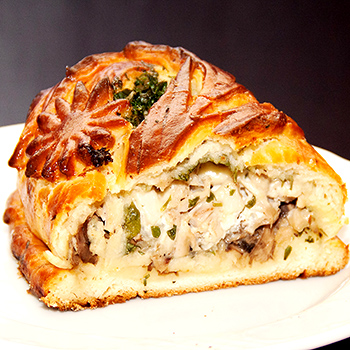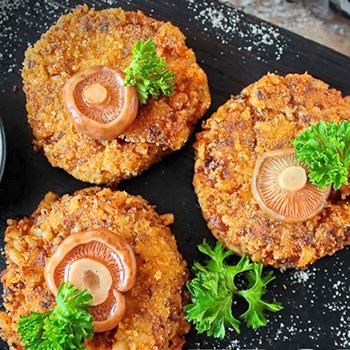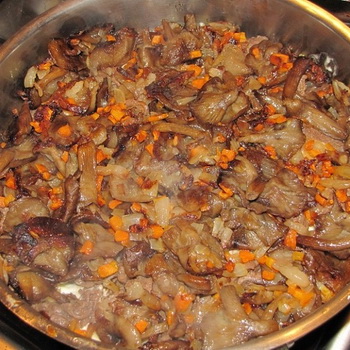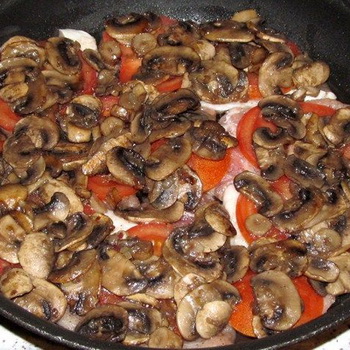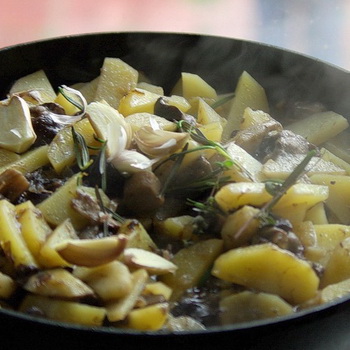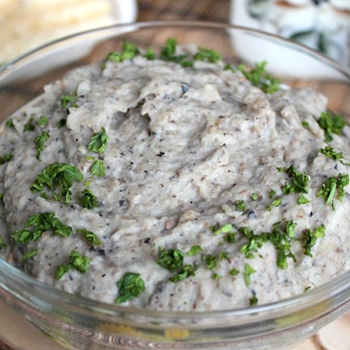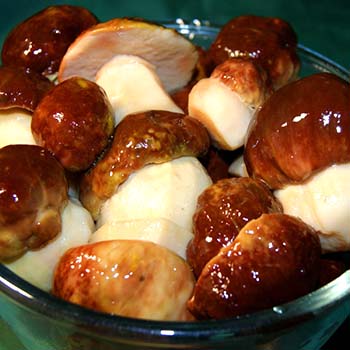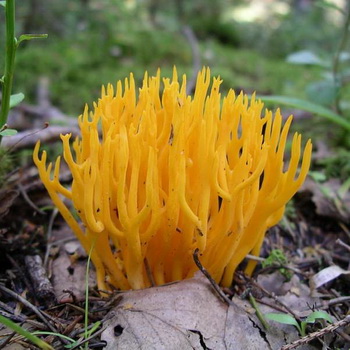Types of mushrooms: a photo and description of what they look like, in which forests the most popular varieties of mushrooms grow
 As soon as July comes, milk mushrooms appear in the forests - one of the most popular mushrooms in Russia. Depending on the species, these fruiting bodies in the mycological classification belong to different categories of edibility (from 1st to 4th). One of the most popular types is real milk mushroom - it is assigned the 1st category of value. Most often, these fruiting bodies are salted and pickled after preliminary soaking and boiling.
As soon as July comes, milk mushrooms appear in the forests - one of the most popular mushrooms in Russia. Depending on the species, these fruiting bodies in the mycological classification belong to different categories of edibility (from 1st to 4th). One of the most popular types is real milk mushroom - it is assigned the 1st category of value. Most often, these fruiting bodies are salted and pickled after preliminary soaking and boiling.
Autumn milk mushrooms are the most delicious and crunchy. It is in September that you can collect baskets with real milk mushrooms. Finding them is not easy as they hide in the grass. Once upon a time there were a lot of them. Since ancient times, milk mushrooms have been salted in barrels and fed on them during fasting. Now there are significantly fewer real mushrooms, and now they most often grow in glades or an open place near the forest zone under small Christmas trees.
You will learn about the forests in which milk mushrooms grow, and how different types of these mushrooms look, after reading this material.
Aspen milk
Habitats of aspen mushrooms (Lactarius controversus): raw aspen and poplar forests. Mushrooms form mycorrhiza with willow, aspen and poplar. These milk mushrooms grow, as a rule, in small groups.
Season: July-October.

The cap has a diameter of 5-18 cm, sometimes up to 25 cm, fleshy with edges sharply curled downwards and a depressed middle, later flat-convex with a slightly deepened center. The color of the cap is white with pale pink spots and weakly visible concentric zones. The surface is sticky and slimy in wet weather. The edges become wavy with age.
Pay attention to the photo - this type of milk mushroom has a short, thick 3-8 cm high and 1.5-4 cm thick legs, dense and sometimes eccentric:

The stem is white or pink, similar in color to the cap, usually with yellowish spots. Often narrowed at the base.

The pulp is whitish, dense, brittle, with a very pungent milky juice and a fruity odor.
The plates are frequent, not wide, sometimes bifurcated and descending along the stem, cream or light pink. Spore powder is pinkish.
Variability. The color of the cap is white or with pink and lilac zones, often concentric. The plates are whitish at first, then pinkish and later light orange.

Similar species. This type of mushroom looks like a mushroom real breast (Lactarius resimus)... However, the latter has a much higher value, its edges are densely fluffy and there is no pinkish color of the plates.
Edible, 3rd category.
Cooking methods: salting after pre-treatment by boiling or soaking.
Real milk
Where do real milk mushrooms (Lactarius resimus) grow: birch and mixed forests, with birch, form mycorrhiza with birch, grow in groups.
Season: July-September.

The cap has a diameter of 6-15 cm, sometimes up to 20 cm, fleshy, with sharply curled down edges and with a depression in the center, later convex-outstretched with a depressed central region. A distinctive feature of the species is the densely fluffy or shaggy edges and the milky white color of the cap, which eventually turns yellow or creamy with or without subtle areas. This type of milk mushroom can have yellowish spots.

Leg 3-9 cm long, 1.5-3.5 cm in diameter, cylindrical, smooth, white, sometimes yellowish or reddish at the base.

The pulp is white, brittle, with a pleasant odor, which gives off a white milky juice that turns yellow in the air and has a pungent taste. The pulp has a fruity smell.
The plates are 0.5-0.8 cm wide, running down the stalk, frequent, white, later yellowish. Spore powder is white.

Similar species. According to the description, this type of milk mushroom is similar to yellow milk mushroom (Lactarius scrobiculatus)which also may have only slightly shaggy edges, a golden yellow or off-yellow color and no fruity pulp odor.
Edible, 1st category.
Cooking methods: salting after pretreatment by boiling or soaking, can be pickled. It has long been one of the most beloved and delicious mushrooms in Russia.
See how real milk mushrooms look in these photos:




Black milk
Black milk mushrooms, or nigella (Lactarius necator) - a favorite delicacy of many Russians due to its crispy state after salting. These mushrooms grow in swampy areas or near damp areas of the forest, often not far from forest paths.
Where black milk mushrooms grow: mixed and coniferous forests, often in clearings, forms mycorrhiza with birch, usually grow in groups.
Season: August-November.

The cap of this type of mushroom mushroom has a diameter of 5-15 cm, sometimes up to 22 cm, at first convex, then smooth with a depressed middle, in young specimens with felt edges bent down, which then straighten out and can be cracked, sticky in wet weather and mucous membrane with subtle concentric zones. A distinctive feature of the species is the dark color of the cap: olive brown or greenish black.

The leg is short, thick, 3-8 cm high and 1.53 cm thick, narrowed downwards, smooth, slimy, generally the same color as the cap, but lighter at the top.
As you can see in the photo, the flesh of this variety of mushrooms is white, turning brown or darkening on the cut:

The pulp abundantly secretes a white, burning milky juice. Spore powder, yellowish.
The plates are frequent, narrow, descending to the pedicle, forked-branched, whitish or pale yellow, often with a greenish tinge, turn black when pressed.
Variability. The color of the cap, depending on the degree of maturity and geographical area, varies from completely black to brown-black.
Edible, 3rd category.
Cooking methods: salting after pre-treatment by boiling or soaking. When salted, the color of the cap turns cherry red or purple-red.
Pepper milk
The season for picking pepper mushrooms (Lactarius piperatus): July-September.

The hat has a diameter of 5-15 cm, first convex, then smooth with a depressed middle, in young specimens with edges bent down, which then straighten and become wavy. The surface is white, dull, often covered with reddish spots in the central area and cracks.

The stem is short, thick, 3-9 cm high and 1.53.5 cm thick, solid and very dense, tapering at the base, with a smooth, slightly wrinkled surface.

The pulp is white, firm, but brittle, with a pungent taste, gives off a white milky juice with a peppery taste, which turns olive green or bluish in air.
The plates are very frequent, descending along the pedicle, whitish, often with a pink tint or reddish spots, not wide, sometimes bifurcated.
Variability. The color of the cap, depending on the degree of maturity and the geographical area, varies from completely white to off-white with greenish or reddish tints. When exposed to air, the white flesh turns greenish-yellow.

Similar species. Pepper milk looks like a mushroom violin (Lactarius volemus), in which the cap has a felt white or white-creamy surface, the milky juice is white, not caustic, turns brown when dry, the plates are creamy or white-cream.
Cooking methods: salting after pre-treatment by boiling or soaking.
Edible, 4th category.

